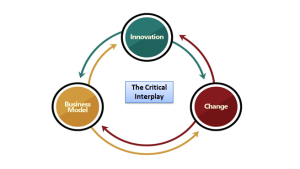 Innovation should be the primary source of real change. Often when exciting new innovations occur they have the power to significantly change our habits, and choice of product, preferences and ways we set about our daily lives.
Innovation should be the primary source of real change. Often when exciting new innovations occur they have the power to significantly change our habits, and choice of product, preferences and ways we set about our daily lives.
Yet why is it we often ignore the power of change when we design innovation?
We often fail to fully appreciate the changes that are occurring from the innovation we produce, it often seems an afterthought, there is this lead and lag effect and needs, firstly recognition and then addressing in how we manage innovation going forward.
In a recent series introduced initially and given a feature of the week prime spot on www.innovationexcellence.com on June 7, 2015, we discussed the importance of the emerging interplays.
This series will be re-produced here as it is an important concept to consider all the aspects within any innovation interplay.
The emerging concept of “interplays”
Jeffrey Phillips of OVO Innovation and I, Paul Hobcraft, through my consultancy work at Agility Innovation Specialists, the co-authors of this series, would argue that we are failing to manage the different and multiple interplays that are constantly taking place when innovation occurs. We are often ignoring them and failing to extract the best or optimal value out of the innovation we are introducing.
 In a White Paper we have just written called “the critical interplay among innovation, business models and change” we provide a foundation document that highlights the important interplay between innovation, business models and change.
In a White Paper we have just written called “the critical interplay among innovation, business models and change” we provide a foundation document that highlights the important interplay between innovation, business models and change.
In this whitepaper we discuss the dynamics and focuses of its impact on all three constituents involved when innovation occurs; that of the customer, the market or industry itself and on the innovator itself.
We used the “lens” of the three horizon model to demonstrate the interplay between innovation, business models and change.
The concept of the interplay – a brief introduction
In this post we introduce the concept of the interplay of innovation to provide a short understanding of this emerging thinking between us and hopefully this encourages you to read the different White Papers that are available on both our web sites (Agility and OVO) to download and read, with my link opening these up directly as pdf’s of one and two here.
We both feel outlining this has only started our thinking to begin our journey to find new ways to frame this ‘interplay’ so it becomes a management discipline, to think far more broadly about the innovation you are designing today.
A series of subsequent posts will delve deeper into specific interplays going on following this introduction which link further with the whitepaper (links for downloading are shown below).
There are interplays constantly at work around innovation that we are failing to fully recognize, manage and leverage.
The vital interplay between innovation, business models and systemic change isn’t fully appreciated; we are failing to appreciate the amount of change that is occurring by innovation and as such failing to leverage it to its most optimal.
We specifically chose the word ‘interplay’ as it means “reciprocal actions, reactions or interactions” and that is exactly what innovation imposes in potential change, to something new, and in altering the existing state, with new business model potential.
It is ‘exerting an influence’ and it is this potential for ‘reaction’ comes from thinking more about the recognition of the value within change and looking to design new business models. One affects the other or has the real potential too, if it becomes an integrated part of the innovation execution process
Any innovation creates change but we have constantly failed to recognize each of the constituent parts this can and does have an impact upon.
Understanding the interplay and why it matters
We tend to understand more and more about a capability as we work with it and learn its capabilities and power. Over time humans have mastered many technologies, from fire to the splitting of the atom.
We believe we are still in the first stages of fully understanding the scope of innovation. Until we recognize the interplay between innovation, business models and change, we cannot fully grasp the potential impact innovation has across horizons, to customers and markets, and most importantly, to the innovator themselves.
Corporate innovation has, to date, been relegated for the most part to incremental improvements, which have little impact on the market or the innovator.
We know this because of how much emphasis we place on the few stories of true disruption – the iPod for example, or how NetFlix destroyed Blockbuster. Increasingly, however, many people are realizing how much power and capability innovation has to offer, and how innovation can create exceptional change, for each of the three constituents noted above.
Further, as we expand the scope and breadth of innovation outcomes, we’ll quickly see that many innovations aren’t simply products, but also new channels, new services, new processes and new business models. As these new innovations emerge more consistently, they will create great change. This becomes part of our need for the interplay
We see different interplays
The first interplay is between innovation, business models and change
As innovation increases, we will see far more variation in the impact and outcomes, which will force business model changes. As industries and competitors adapt to the increasing pace of innovation, the pace and scope of change will increase as well, leading to more business model shifts and more potential innovation activity.
These three factors create a virtuous (to some) or vicious (to others) cycle, depending on the organization’s ability to sustain innovation, change and evolve business models.
The second interplay is between the three primary constituents involved
Innovation has an impact on at least three constituents: customers, the markets and the industries themselves but also internally on the innovator themselves.
1) The customer as the first constituent
These are at the customer, where the ‘job’ your product or new service is seeking to resolve often requires very different actions, behaviours or beliefs, firstly to adopt the innovation but then to ‘extract’ the advantage gained in making the change.
We believe we fail to provide enough of the positives of this change, often they are discovered through trial and error or through a newly forming community that shares their knowledge. Customers experience change from any innovation they adopt.
2) The Market and your competitors as another constituent
Each industry has established ‘norms’ that are increasingly under attack from new business models, and new competitive threats that are not bound by these norms.
We are seeing many conventions previously established being challenged not just by innovation itself but by the clear use of the business model to explore all the options available. New innovations often create change for competitors or the industry at large.
3) Then we have the innovator themselves
What is so staggering to us is how many innovators are refusing to recognize that innovations always create change that has a significant effect on the innovator themselves. We must ask – why is that the case? Often by not understanding the scope of change, they are attempting to create they totally miss the business opportunities that could come with it.
Change is still seen internally as something to be avoided, often at all costs, but we would argue most strongly to embrace change before a lack of change destroys you. Innovators are not immune from the change they create.
The third interplay is the three horizons to manage innovation and change
To explain the impacts of innovation and the change it creates, we’ll use an accepted framework (the Three Horizons) to consider the impact innovation has on change capabilities and business models.
What’s important to understand is that every innovation creates change, and the amount and impact of change scales out across each of these three horizons into different business model opportunities
Change today is, without doubt, a constant
We need to create a new interplay design. Before we can embrace constant change we need to see the effect of change certainly in more positive ways.
There is really no “steady state” anymore, change through innovation will become the predominant state. Change and innovation become constants, as business models continually evolve. It is reducing the fear and uncertainty of change by taking a totally different view of the value of innovation that we can alter today’s change perspective.
Organizations need to become more excited about pursuing new business opportunities, looking for new business models to change the existing dynamics.
It is totally energizing to try out new things, design a more holistic innovation experience that accounts for the customer and the market and constantly experiment with all that does ‘interplay’ around innovation.
Managing the interplay of innovation, business models and change
You do need to pass through different phases of understanding, of awareness and recognize the increasing interplay undertaken by combining innovation, business models and change across all three constituents of the customer, the market and yourself as the innovator, through a lens that sees emerging opportunity across different horizons.
In our white paper “the critical interplay among innovation, business models and change” we provide a foundation document that highlights the important parts of a new interplay that needs recognition, framing even more and a fresh approach to building the competencies, capabilities and capacities to manage the interplay of future innovation opportunity.
A place where you are seeking the power and impact of innovation lies in the interplay between change and new business designs.
To obtain the White Paper you can DOWNLOAD by going to
https://ovoinnovation.wordpress.com/thought-leadership/ or
The original post was published on www.innovationexcellence.com on June 7, 2015
3 thoughts on “The Interplay Surrounding Innovation”
Comments are closed.